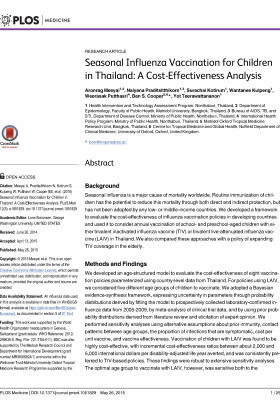This website uses cookies so that we can provide you with the best user experience possible. Cookie information is stored in your browser and performs functions such as recognising you when you return to our website and helping our team to understand which sections of the website you find most interesting and useful.
Seasonal Influenza Vaccination for Children in Thailand: A Cost-Effectiveness Analysis (2015)

Details
Aronrag Meeyai1,2, Naiyana Praditsitthikorn1,3, Surachai Kotirum1, Wantanee Kulpeng1,Weerasak Putthasri4, Ben S. Cooper5,6*, Yot Teerawattananon1
1 Health Intervention and Technology Assessment Program, Nonthaburi, Thailand, 2 Department of Epidemiology, Faculty of Public Health, Mahidol University, Bangkok, Thailand, 3 Bureau of AIDS, TB, and STI, Department of Disease Control, Ministry of Public Health, Nonthaburi, Thailand, 4 International Health Policy Program, Ministry of Public Health, Nonthaburi, Thailand, 5 Mahidol Oxford Tropical Medicine Research Unit, Bangkok, Thailand, 6 Centre for Tropical Medicine and Global Health, Nuffield Department of Clinical Medicine, University of Oxford, Oxford, United Kingdom
Abstract
Background
Seasonal influenza is a major cause of mortality worldwide. Routine immunization of children has the potential to reduce this mortality through both direct and indirect protection, but has not been adopted by any low- or middle-income countries. We developed a framework to evaluate the cost-effectiveness of influenza vaccination policies in developing countries and used it to consider annual vaccination of school- and preschool-aged children with either trivalent inactivated influenza vaccine (TIV) or trivalent live-attenuated influenza vaccine (LAIV) in Thailand. We also compared these approaches with a policy of expanding TIV coverage in the elderly.
Methods and Findings
We developed an age-structured model to evaluate the cost-effectiveness of eight vaccination policies parameterized using country-level data from Thailand. For policies using LAIV, we considered five different age groups of children to vaccinate. We adopted a Bayesian evidence-synthesis framework, expressing uncertainty in parameters through probability distributions derived by fitting the model to prospectively collected laboratory-confirmed influenza data from 2005-2009, by meta-analysis of clinical trial data, and by using prior probability distributions derived from literature review and elicitation of expert opinion. We performed sensitivity analyses using alternative assumptions about prior immunity, contact patterns between age groups, the proportion of infections that are symptomatic, cost per unit vaccine, and vaccine effectiveness. Vaccination of children with LAIV was found to be highly cost-effective, with incremental cost-effectiveness ratios between about 2,000 and 5,000 international dollars per disability-adjusted life year averted, and was consistently preferred to TIV-based policies. These findings were robust to extensive sensitivity analyses. The optimal age group to vaccinate with LAIV, however, was sensitive both to the willingness to pay for health benefits and to assumptions about contact patterns between age groups.
Conclusions
Vaccinating school-aged children with LAIV is likely to be cost-effective in Thailand in the short term, though the long-term consequences of such a policy cannot be reliably predicted given current knowledge of influenza epidemiology and immunology. Our work provides a coherent framework that can be used for similar analyses in other low- and middle-income countries.
Full text can be accessed from:
http://journals.plos.org/plosmedicine/article?id=10.1371/journal.pmed.1001829




